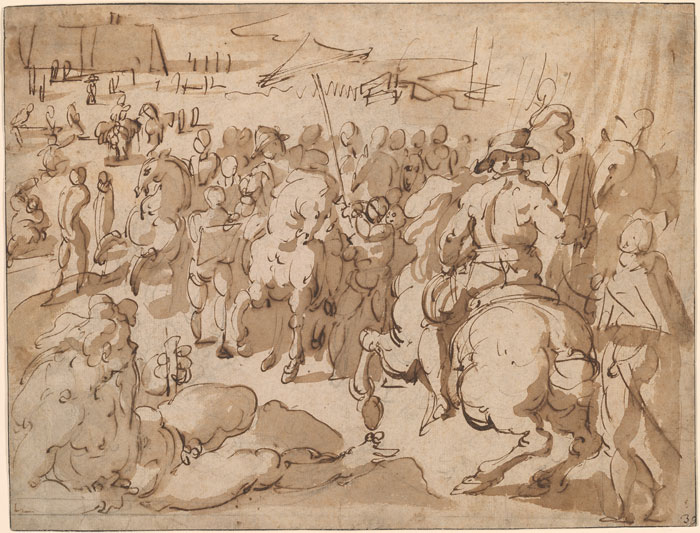
Jacopo Zucchi was born around 1540 in Florence. By 1557 he was already in the entourage of Vasari, from whom he presumably acquired his artistic training. Along with Stradanus and Naldini, Zucchi was one of Vasari’s primary assistants in the decoration of the Palazzo Vecchio and in the creation of the ephemeral decorations associated with the wedding ceremony of Francesco de’ Medici and Joanna of Austria held there in December 1565, schemes that were executed by Vasari and his assistants according to the complex programs devised by Vincenzo Borghini.1 Zucchi later accompanied Vasari to Rome to work on projects in the Vatican, but, when Vasari returned to Florence in 1572, Zucchi remained in Rome. He became the principal artist to Cardinal Ferdinando de’ Medici at the Villa Medici and later received many private and ecclesiastical commissions. Responsible for paintings ranging from brilliant small copper panels to enormous frescoes, from allegorical scenes to altarpieces, Zucchi was consistently successful, and his elegant Mannerist style satisfied both sophisticated connoisseurs and Counter-Reformation churchmen.
The present drawing was identified as the work of Stradanus when it made its first appearance on the market in 1976, but it was recognized as Zucchi’s work by Ted Pillsbury, who had then recently published the first article on Zucchi as a draftsman, and by Ralph Holland. The two competed for the drawing at the 1976 sale, with Holland the successful purchaser. Holland published the drawing as Zucchi’s work in 1982, but the subject of the sheet was not identified until 2005, when Florian Härb connected it with the decorations set up in Palazzo Vecchio for the Medici wedding.2
Vasari and his entourage had completed the ceiling paintings of the Sala Grande just before the wedding, but the mural decorations were still incomplete. The temporary decorations installed along the upper register of the walls included four chiaroscuro paintings in the corners of the room, two each by Naldini and Zucchi, which recorded the expansion of Medici dominion. Naldini’s paintings were of the Draining of the Marshlands and the Fortification of Cosimo’s Dominion, while Zucchi was responsible for the Delivery of the Keys of Livorno and the Foundation of Cosmopoli. A drawing in the Louvre (Musée du Louvre, Paris, inv. 22597) has long been identified as a study for the former, and Härb recognized that the ex-Holland drawing was for the latter scene.3 Although the drawing is of a different type from the Louvre Delivery of the Keys of Livorno—the Louvre study is a highly finished modello, while the present drawing is a more lively primo pensiero—their similar format and mirrored compositions confirm that they were surely for the paintings installed at the upper corners of the Sala Grande.4
In the Foundation of Cosmopoli, Cosimo appears on horseback at center, under a parasol held by an attendant and consulting with an architect who presents the plans for the building of the fortress at Portoferraio, which was then, in 1548, renamed Cosmopoli. The fortress rises at upper left, while the coastline of Elba is indicated with the curving line and wash at upper center. The large reclining figure at lower left is a personification of the Tyrrhenian Sea, metaphorically subject to Medici rule. It is significant that the horseman at lower right appears not in armor but in ceremonial dress, indicating that the Medici takeover and fortification of Elba in 1548 was not a case of military seizure but rather occurred at the prompting of the emperor Charles V and the invitation of the ruling family.
Livorno and Elba seem today to be odd choices for epithalamic decorations, but, like the scenes on the ceiling of the Sala Grande, they represented the rise of the Medici as a European power. The Medici possession of the two ports effectively gave Florence control of shipping in the Tyrrhenian Sea, marking the Medici as possessors of maritime power and not merely the banker-oligarchs of landlocked Florence. (Bartolomeo Ammanati’s Neptune Fountain, created outside Palazzo Vecchio in 1565, was similarly a reminder of Florence’s new maritime prowess, and the fortifications at Cosmopoli also appear in Vasari’s decorations for the Room of Cosimo in the Palazzo Vecchio.) The 1565 wedding of Francesco de’ Medici to Joanna of Austria, a daughter of Emperor Ferdinand I, likewise confirmed the Medici as players on the European stage and was to some extent the satisfaction of their dynastic ambitions.
Despite the complicated subjects provided to the artists by Vincenzo Borghini, one of the quintessential aspects of later Florentine draftsmanship was the requirement that artists devise compositions that told these complicated stories while maintaining a sense of Mannerist grace and inventiveness. As Vasari advised his followers, “bozze (sketches) are used to draft a composition, but roughly, with minimal attention to detail. The artist should [in this first moment] work rapidly, with furore, to stretch his ingenuity.”5 It would be difficult to imagine a sheet more representative of this directive than the present work.
—JJM
Footnotes:
- On the decorations for the Medici wedding, see Scorza 1981 and Scorza 1985; see also No. 100, another drawing created in connection with the 1565 wedding decorations.
- Newcastle upon Tyne 1982, no. 14; Härb 2005, no. 59.
- Pillsbury 1974, 7; see also Allegri and Cecchi 1980, 275–76.
- The same subjects were later intended for (unexecuted) frescoes in the basamento of the Sala Grande (see Florence 2002, 93–97, and Pillsbury 1973, 9–10). Given the very different upright and octagonal format of the basamento scenes, Zucchi’s drawings were certainly for the earlier 1565 decorations.
- Vasari 1878–85, 1:174.
Inscribed at lower right, in pen and brown ink, "39".
Crozat, M. (Pierre), 1661-1740, former owner.
Holland, Ralph, 1917-2012, former owner.
Rhoda Eitel-Porter and and John Marciari, Italian Renaissance Drawings at the Morgan Library & Museum, New York, 2019, no. 99.
Selected references: Newcastle upon Tyne 1982, no. 14; Härb 2005, no. 59.
